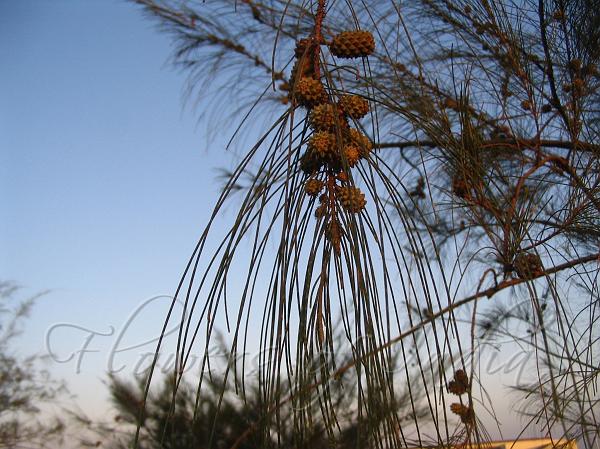|
| Whistling Pine |
|

|

| File size | 1001586 |
| Original date | 8/19/07 7:25 AM |
| Resolution | 2048 x 1536 |
| Flash | Flash did not fire, auto |
| Focal length | 5.40625mm |
| Exposure time | 1/400s |
| Aperture | 2.8 |
| Focus Distance | |
| Metering Mode | Multi-segment |
| Camera make | Canon |
| Camera model | Canon PowerShot A75 |
| Sensor type | OneChipColorArea |
|
|
|
Photo: |
Botanical name: Casuarina equisetifolia Family: Casuarinaceae (casuarina family)
Whistling Pine is a common tropical seashore tree and is often planted as a
windbreak. Whistling Pine has a conifer-like
appearance which is increased by hanging green branchlets and cone-like
fruits. The species name equisetifolia refers to the resemblence of
the leaves to a horse’s tail. The soft singing of the air through its
innumerable slender twigs is a pleasant sound, which lends it the common name
Whistling Pine. It is a large vase-shaped tree that grows 100-150 ft in
height with wispy grey green twigs reminiscent of pine needles. The weeping
branchlets look a little like jointed rushes and are ringed at their nodes by
tightly overlapping little scalelike leaves. The stout trunk is covered with
thick pebbly textured brownish grey bark. The male flowers are borne in
slender cylindrical spikes at the twig tips. The tiny brownish red female
flowers grow in heads attached to the branchlets and are followed by 0.5 in
diameter fruits that resemble pinecones and contain 70-90 winged
seeds each. The wood is hard and
is almost unworkable by carpenters. It also cracks
and splits easily and so is more suitable for beams or posts than planks, but
does not last long underground. The chief use is as
fuel for which a tree may be cut when 10 to 12 years old, although it is
better left until about 20.
| Identification credit: Tabish | Photographed in Goa & Delhi. |
• Is this flower misidentified? If yes,